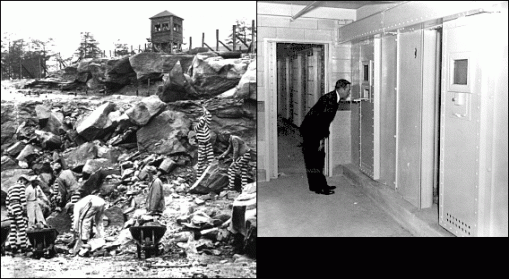Treatment of Prisoners
within the nineteenth century
By: Alex
During the 19th century many convicted Americans attended the Auburn State Prison or the Eastern State Penitentiary.
The Auburn State Prison is located on State Street in Auburn, New York. The prison is classified as a maximum security facility. It was the first state prison in New York. The Auburn Prison held the site of the first execution, by electric chair, in 1890. The prison charged a fee for tourists. The money from the tourists went to raise funds for the prison. The prisoners in the Auburn State Prison were forced to work during the day. Their labor helped to support the prison. Prisons were segregated by their crime. Each group of prisons based on the crime they committed were kept away from other prisons, and forced to wear different clothes to distinguish the seriousness of their crime. Prisoners normally wore horizontal black and white stripes. During meals, prisoners were allowed to sit next to each other in a dining hall, but complete silence was enforced. While working they were forced to be in complete silence also. Inmates were kept in individual cells, to reflect upon the crime they committed. Any misbehavior cause inmates to be physically punished.
The Eastern State Penitentiary is a former state prison located in Philadelphia, Pennsylvania. The goal this penitentiary was to isolate prisoners from one another, trying to prevent the spread of disease. Over 300 prisons worldwide followed the design of the Eastern State Penitentiary, agreeing with the solitary confinement of inmates. The word Penitentiary comes from the word penance. The goal for the prisoners was to want to open up to God. The inmates cells were separated by a metal door and a wooden door to filter out all noise. The doors of their cell were very small, eliminating attacks to the guards. The cell contained a single glass skylight, trying to make the inmates believe that the glass represented the "Eye of God". The prisoners believed the God was always watching them. Outside of their cell there was room for exercise, but they were in closed in high walls so they couldn't communicate. No two prisoners would be working out at the same time. The Eastern State Penitentiary eliminated much of the excess punishment. The solitary confinement caused mental problems among the prisoners. The solitary confinement quickly was eliminated, due to the overcrowding problems. By 1913, the Eastern State Penitentiary abandoned the believe in solitary confinement, and turned to allowing interaction between inmates. The objective of the Eastern State Penitentiary was not to just punish, but to make the inmates believe in change.
Paragraph.

